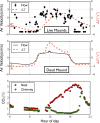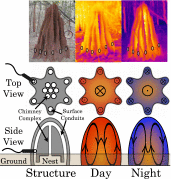Termite mounds harness diurnal temperature oscillations for ventilation
- PMID: 26316023
- PMCID: PMC4577200
- DOI: 10.1073/pnas.1423242112
Termite mounds harness diurnal temperature oscillations for ventilation
Abstract
Many species of millimetric fungus-harvesting termites collectively build uninhabited, massive mound structures enclosing a network of broad tunnels that protrude from the ground meters above their subterranean nests. It is widely accepted that the purpose of these mounds is to give the colony a controlled microclimate in which to raise fungus and brood by managing heat, humidity, and respiratory gas exchange. Although different hypotheses such as steady and fluctuating external wind and internal metabolic heating have been proposed for ventilating the mound, the absence of direct in situ measurement of internal air flows has precluded a definitive mechanism for this critical physiological function. By measuring diurnal variations in flow through the surface conduits of the mounds of the species Odontotermes obesus, we show that a simple combination of geometry, heterogeneous thermal mass, and porosity allows the mounds to use diurnal ambient temperature oscillations for ventilation. In particular, the thin outer flutelike conduits heat up rapidly during the day relative to the deeper chimneys, pushing air up the flutes and down the chimney in a closed convection cell, with the converse situation at night. These cyclic flows in the mound flush out CO2 from the nest and ventilate the colony, in an unusual example of deriving useful work from thermal oscillations.
Keywords: ecosystem engineering; niche construction; termite mound; thermodynamics; ventilation.
Conflict of interest statement
The authors declare no conflict of interest.
Figures





References
-
- Kleineidam C, Roces F. Carbon dioxide concentrations and nest ventilation in nests of the leaf-cutting ant Atta vollenweideri. Insectes Soc. 2000;47:241–248.
-
- Seeley TD. Atmospheric carbon dioxide regulation in honey-bee (Apis mellifera) colonies. J Insect Physiol. 1974;20(11):2301–2305. - PubMed
-
- Von Frisch K, Von Frisch O, Gomrich L. Animal Architecture. Harcourt Brace Jovanovich; New York: 1974.
-
- Korb J. Termite Mound Architecture, from Function to Construction. In: Bignell DE, Roisin Y, Lo N, editors. Biology of Termites: A Modern Synthesis. Dordrecht; Netherlands: 2011. pp. 349–373. - PubMed
-
- Turner JS. Architecture and morphogenesis in the mound of Macrotermes michaelseni (Sjöstedt) (Isoptera: Termitidae, Macrotermitinae) in northern Namibia. Cimbebasia. 2000;16:143–175.
Publication types
MeSH terms
Substances
LinkOut - more resources
Full Text Sources
Other Literature Sources

